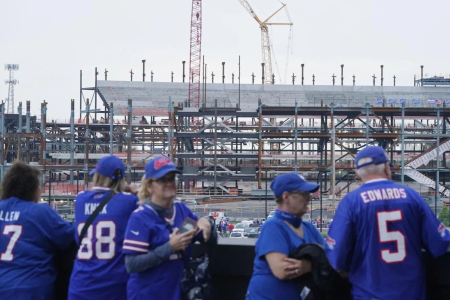
Three years and $850 million later, did taxpayers get a good deal on the new Bills stadium?
The price tag for the Bills’ stadium has soared to more than $2.1 billion – with the team picking up all the cost overruns. It’s dropped the public funding portion of the project by over 20%.
From the The final stretch: The journey to a new Buffalo Bills stadium
When the deal to pay for the new Buffalo Bills stadium was revealed in March 2022, supporters said the agreement protected taxpayers’ interests while keeping the team in one of the league’s smallest markets for decades to come.But critics pounced on its $850 million in public funding, the largest payout for any National Football League stadium up to that point.
Funding from the state and Erie County made up 61% of the cost of what was then a new $1.4 billion stadium in Orchard Park.
In the 3½ years since, however, more than half a dozen other NFL communities have reached, or are negotiating, new stadium deals of their own. Some will require public investments of over $1 billion, while other teams say they’ll fully finance the stadium construction.
At the same time, the price tag for the Bills’ stadium, scheduled to be substantially completed in July 2026, has soared to more than $2.1 billion – with the team picking up all the cost overruns. It’s dropped the public funding portion of the project by over 20%.
If the financial agreement for the new stadium was a Bills draft selection, we would know by now whether the pick was a success or a bust.
So, it’s time to ask the same question of the 2022 stadium deal: In hindsight, how well has it aged?
“I mean, it no longer is, sort of, world historically awful,” said Neil deMause, an authority on sports stadium financing and author of the book “Field of Schemes.” “But I don’t know that that’s so much as it looks better, or that other deals look worse.”
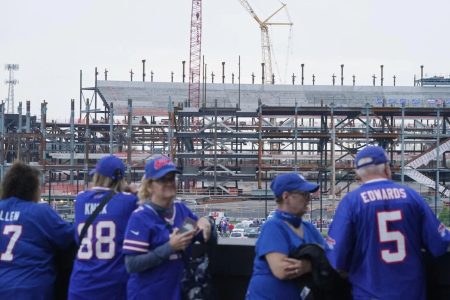
Bills fans take in the view of the new stadium construction from the mezzanine level before a game against the Jacksonville Jaguars
at Highmark Stadium in Orchard Park on Sept. 23, 2024. Derek Gee/News file photo
Public share shrinks
The state and county point to their persistence in making sure the Bills paid for any cost overruns, which have totaled around $800 million. The Bills say owner Terry Pegula has never deviated from the plan to pay what it takes to build a state-of-the-art stadium.“The participation of the state and county, along with Terry’s unwavering commitment to the market, has allowed us to create a best-in-class stadium for our fans and team that many did not think was possible here,” said Pete Guelli, executive vice president and chief operating officer for the Bills. “The project has turned into the ultimate win-win for our area.”
The new stadium for the Bills has gone up in price by approximately 50%. Now, at $2.1 billion, the public funding covers about 40%, not 61%, of the total.
The difference is significant for Pegula; his share of the project has soared from around $500 million to $1.25 billion.
And the county’s $250 million commitment, as a share of the overall cost, has fallen to just under 13%, Erie County Executive Mark Poloncarz said.
“We put in a much smaller proportion, when all is said and done, of the cost associated with construction than what a lot of our counterparts have done elsewhere, and we got strong non-relocation terms that ensure that our team is staying here for a long time,” he said, noting the 30-year lease.
Previously, the high mark for public funding for an NFL stadium was set by the $750 million for Allegiant Stadium, the Las Vegas Raiders’ home since 2020.
Victor Matheson, an economics professor at Holy Cross, said the deal didn’t get better in Western New York because the Bills are now taking on more of the cost.
“It’s still money out of taxpayers’ pockets,” Matheson said, “so calling it a low percentage is wildly disingenuous.”
He does credit Erie County and the state for ensuring the Bills took on cost overruns but said this was needed since the Bills asked to manage the public-private backed project.
“That can be forgotten about and then the public is on the hook for a much bigger portion than they had thought,” Matheson said.
Guelli said collaboration with the state and county was a “critically important part of the process.”
In a small market such as Buffalo, there is always the threat of a team leaving for greener pastures, such as Austin, Texas. Poloncarz pointed to the cities of St. Louis, Oakland and San Diego that all had, and lost, NFL teams in recent years. “And they’re all bigger markets than Buffalo,” he said.
The state, which will own the stadium property, also agreed to pay $6 million annually for 30 years into a capital improvement fund and $6.7 million annually for 15 years into a maintenance and repair fund – or $280 million over the lease’s length.
“In developing this partnership, they clearly understood the value of securing the Bills in Buffalo for the long term,” Guelli said, “and what it takes to compete within the current NFL landscape, particularly as a small-market team.”
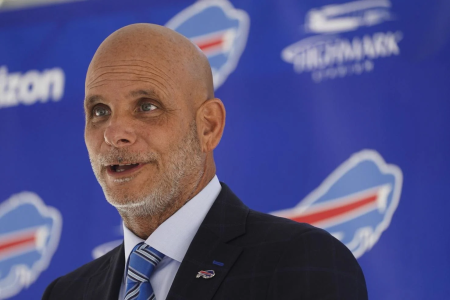
“The project has turned into the ultimate win-win for our area,” said Pete Guelli, Bills COO and executive vice president.
Joshua Bessex, Buffalo News
Stadium deals compared
If anything makes the Bills deal look better, it’s the agreement made in Nashville for the new domed stadium for the Tennessee Titans, Matheson said.That city and state agreed to put $1.26 billion in public money, or 60% of the cost, toward a $2.1 billion stadium, part of a project including extensive surrounding development.
The Titans are halfway through the construction of their stadium, slated to be done in time for the 2027 season.
“What doesn’t make sense is this idea that you have to give these big subsidies to an NFL team,” Matheson said, “and it makes even less sense in a fast-growing city like Nashville, because there’s nowhere else that they were going.”
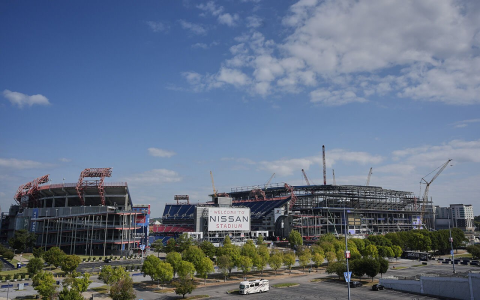
The Tennessee Titans current stadium is seen, left, as construction continues on a new enclosed stadium for the NFL football team, right, on Sept. 9, 2025, in Nashville, Tenn. Associated Press
The Bills deal is different than many modern-day stadium projects, because it’s strictly for a stadium and not connected to mixed-use development or an entertainment district.
The domed Titans stadium is billed as a major tourist attraction, putting a renewed spotlight on Nashville and attracting bigger events like the Final Four and Super Bowl.
But, in Western New York − where it is less populated and tourism is not as prevalent than in D.C. and Nashville − there isn’t the same market for development with restaurants, retail and housing. It would likely only take away from other local areas offering similar amenities, experts said.
Plus, spending hundreds of millions of dollars more for a domed stadium likely wouldn’t have been worth it, because the area doesn’t have enough size and hotel access to host the biggest events.
In Washington, D.C., the city recently approved investing a little over $1 billion in a $3.7 billion project for the Commanders that includes a domed stadium, and ancillary development, on and around the former RFK Stadium site, where Washington’s football team used to play.
The team likely wasn’t going to leave the area but was able to leverage the potential for competing stadium sites in Landover, Md. – their current home − and Virginia.
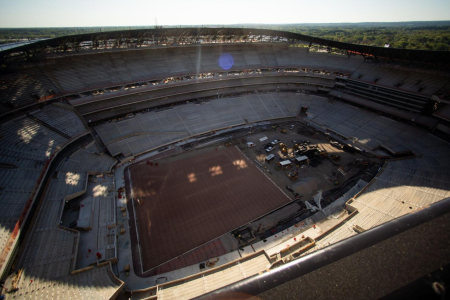
The price tag for the Bills’ stadium, set to be substantially completed next July, has soared to more than $2.1 billion
– with the team picking up all cost overruns, dropping the public’s total share. Joshua Bessex, Buffalo News
‘Enough is enough’
Steven Ranalli, president of the Erie County Stadium Corp., which oversees construction of the new Bills stadium, pointed out the team and its public-sector partners are paying to replace 52-year-old Highmark Stadium, while several new stadiums proposed elsewhere, such as Nashville and Cleveland, would replace venues that aren’t even 30 years old.And, he said, some elected officials are touting full private financing for their stadiums, but public money will go toward roads, utilities and other costs for work around the new venues.
“You’re going to see some significant dollars, public dollars, to support those infrastructure upgrades,” Ranalli said. “So, maybe they’re not exactly going to pay for seats, or TV screens, or whatever the case may be. But they’re going to be needed to get those deals over the hump.”
However, the Bills stadium deal must be understood in the broader context of the Trump administration’s funding cuts and the state’s prior “Buffalo Billion” aid for projects like the Tesla Gigafactory 2, said Ron Deutsch, director of the New Yorkers for Fiscal Fairness advocacy group.
“New York is losing billions of dollars in federal aid right now. Yet we’re still squandering nearly a billion dollars on a new stadium. We’re still providing Elon Musk with basically rent-free space in Buffalo,” Deutsch said. “I think at some point we have to say enough is enough, and that we can’t keep giving billionaires subsidies when so many New Yorkers are struggling.”
Chris Ronayne, county executive of Cuyahoga County, home to Cleveland and its Browns, said he doesn’t want county taxpayers to pay for the team’s planned move from downtown to a new suburban stadium.
“Owners learn something, which is, ‘We can fleece the public with the best deal that the last guy got,’ “ Ronayne said. “But the public’s getting smart, and the public’s pushing back, and the public is saying, ‘We’re not gonna get fleeced.’ ”
Helen “Nellie” Drew, who teaches sports law and oversees the University at Buffalo’s Center for the Advancement of Sport, agreed voters and public officials in some markets have started to reject the idea of giving taxpayer money to wealthy NFL owners.
But teams like the Bills generate national publicity, visits from out-of-town fans and tax revenue that make it hard to say no entirely, she said.
“We live in a world where there are 32 teams, and if you want one, you’re going to have to pony up,” Drew said. “Is that fair of the NFL when they print money? No. But until you change the rules, it’s going to happen.'

